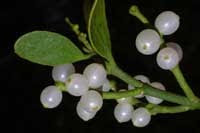Read this (and eat this) before you pucker up this holiday season (All about mistletoe!)
It goes without saying, then, as curious minds tend to do, I have recently overloaded my brain with as much knowledge of mistletoe that I could find.
And wow, who knew that such a small little plant that I have thumbtacked into my molding could hold such a myriad of stories…
 First of all, the name itself. According to a USGS web page, the name mistletoe (from mistletan) is derived from early Anglo-Saxon words of mistle, meaning “dung,” and tan, meaning “twig” because it was thought that bird droppings were the cause of the growth of this mysterious plant. So literally, well, you can figure that out for yourself.
First of all, the name itself. According to a USGS web page, the name mistletoe (from mistletan) is derived from early Anglo-Saxon words of mistle, meaning “dung,” and tan, meaning “twig” because it was thought that bird droppings were the cause of the growth of this mysterious plant. So literally, well, you can figure that out for yourself.Scientifically the plant’s name is a little cleaner: Phoradendron, meaning “thief of the tree” in Greek, because mistletoe is actually a parasitic plant. Basically, the seed of the plant is transported to another tree and hooks itself on and sucks the nutrients from its host while it grows. Some scientists now recognize that it is only semi-parasitic, because it has green leaves (and can make its own food), but that just leads to more questions…
Such as, the leaves stay green in the winter, which is kind of neat and apparently people hundreds and hundreds of years ago thought so too, which leads to more questions…
Such as, why in the world would we hang a plant that literally means, well, you know, in our homes with the hopes of kissing under it?
Which brings us to ancient Scandinavia and Viking lore, which I know has nothing to do with Christmas, but hang in there.
Despite numerous conflicting histories online, the best I can figure is that some Goddess, Frigga, had a son who had a run in with a jealous God who did him in with some sort of dart made of mistletoe. I personally think the thumbtack is a better choice of weapon, but in any case, mama Frigga wept tears that turned into white berries, and decreed that the mistletoe should be a symbol of love from here on out.
Combine that with the fact that the plant is also a symbol of fertility in some cultures, and you’ve got a recipe for smooches galore over the holiday season. Some folklore believes that for every kiss, a berry should be plucked. Other traditions think that if a single woman doesn’t receive a kiss under the mistletoe, she will not marry in the next year.
Whatever you believe, the next time someone meets you under the mistletoe and puckers up, instead of closing your eyes, look up and take note of an interesting plant with an interesting history, and an even more interesting name.
MINTY FRESH FOR THE MISTLETOE
OK, so these won’t really improve your breath, but they are still delicious!
Ingredients:
3/4 cup butter
1 1/2cups brown sugar
2 Tbl. water
2 cups semisweet chocolate chips
2 eggs
2 1/2cups flour
1 1/4 tsp. baking soda
1/2 tsp. salt
3 (4.5 oz.) packages chocolate covered mint candies (such as Andes)
Combine sugar, butter, and water in a saucepan and cook over medium heat until melted. Remove from heat and stir n the chocolate chips until melted. Set aside to cool for 15 minutes.In a large bowl, beat the chocolate mixture and eggs. Add the baking soda and salt and mix. Then add the flour and mix until the dough forms. Cover and refrigerate for at least an hour.
Scoop dough with a tablespoon onto greased cookie sheets and bake at 350 for 8-10 minutes, careful not to overbake.
When cookies come out of the oven, immediately place a mint candy (or half a candy, depending on the size of your cookies) and let it get soft. Then swirl the candy with a toothpick to make a green and brown pattern pretty and tasty enough to get anyone you want under the mistletoe.


Comments